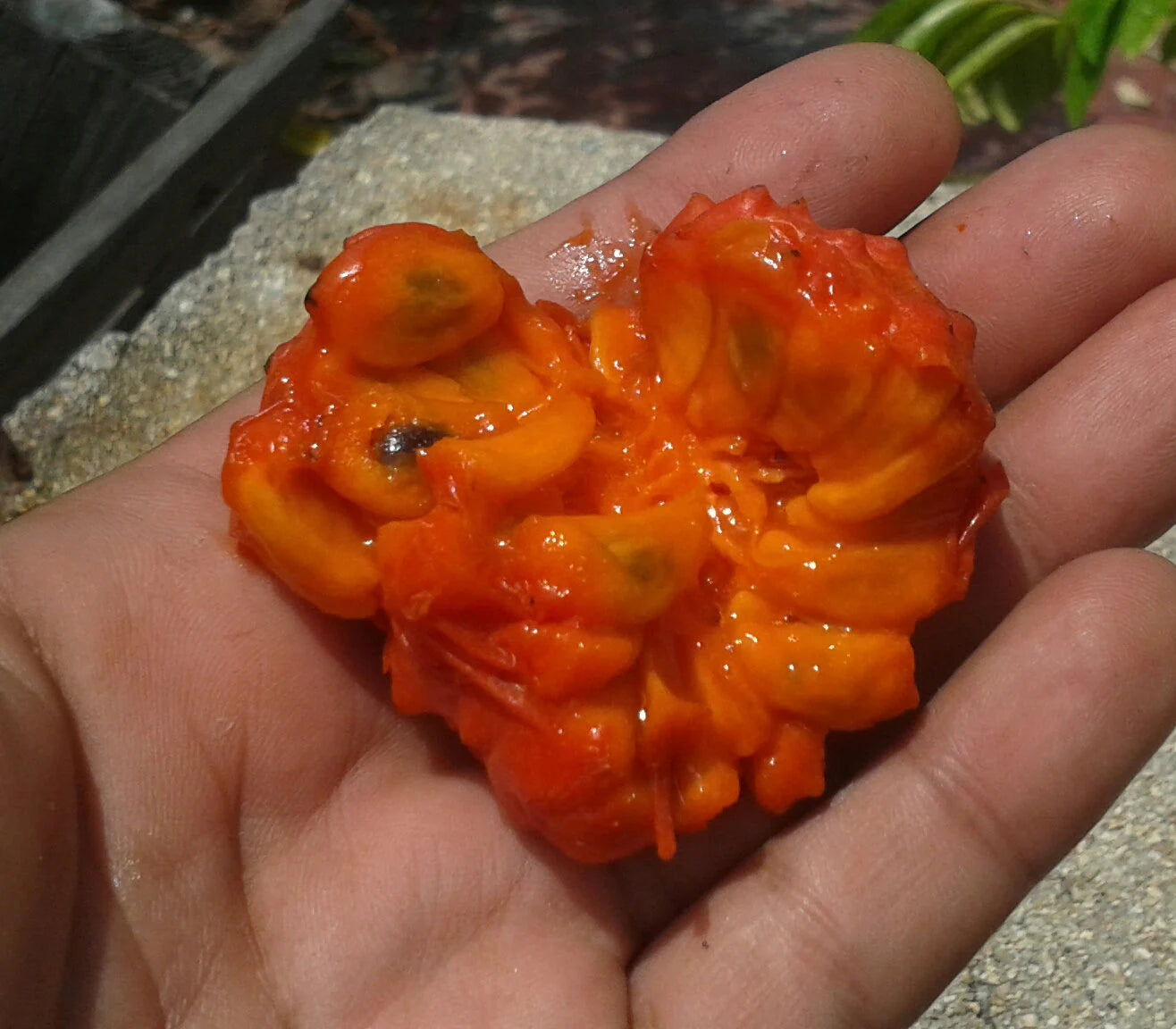Love it? Add to your wishlist
Your favorites, all in one place. Shop quickly and easily with the wishlist feature!
[message]
[title]
[message]




Veliyath Gardens
Couldn't load pickup availability
Red Arachitchu Fruit Plant (Annona Cornifolia): A Unique Tropical Delight
The Red Arachitchu (Annona cornifolia), also known by various common names such as Ariticum De Raposa, Ata De Cobra, and Atinha Do Campo, is an exotic and rare fruit plant native to the tropical regions of South America. Originating from Central and Eastern Brazil, as well as Bolivia, this slow-growing shrub offers a distinctive fruit with a sweet and aromatic pulp. Known for its vibrant color, unique flavor, and potential health benefits, the Red Arachitchu is a plant worth exploring for gardening enthusiasts and health-conscious individuals alike.
The Red Arachitchu is a slow-growing shrub that typically reaches a height of 2 to 3 meters. It thrives in sunny positions, making it well-suited for warm, tropical environments. Native to Brazil and Bolivia, it prefers acidic, sandy soils and requires excellent drainage to flourish. This plant is an excellent addition to gardens that mimic its native habitat, with its ability to adapt to specific soil conditions and its relatively low-maintenance needs.
The Red Arachitchu is distinguished by its small but striking orange-red fruit, which has a diameter of about 2 to 3 cm. The fruit contains a highly sweet pulp that transitions from orange to red as it ripens. Known for its delicious flavor, it is used in both culinary and medicinal applications, offering both nutritional and health benefits.
The Red Arachitchu fruit's pulp is a true delight for the senses. The fruit's sweet, juicy, and tangy pulp is often consumed directly as a fresh snack or used in various culinary dishes. The pulp can be incorporated into smoothies, desserts, salads, and even savory dishes, making it a versatile fruit for a variety of cuisines. Additionally, it can be used to prepare refreshing fruit juices, adding a natural sweetness to beverages. This fruit's rich flavor makes it a popular ingredient in regional South American cooking, especially in traditional recipes from Brazil.
The Red Arachitchu is not only delicious but also packed with essential nutrients. Although detailed nutritional data is limited, its sweet pulp is a good source of:
In addition to its culinary uses, the Red Arachitchu plant has traditional medicinal applications, particularly for its stress-relieving properties. The plant's flowers, including those of Annona cornifolia, are known for their calming effects, which are often utilized in herbal medicine to promote mental peace and relaxation. In South American folk medicine, the fruit and its flowers are sometimes used as part of stress-reduction and mood-enhancing remedies.
Additionally, the plant has potential antimicrobial and anti-inflammatory properties, although further scientific studies are needed to confirm these claims. The calming properties of the fruit are particularly valuable in modern herbal practices, where natural remedies for anxiety and stress are in demand.
The Red Arachitchu is not only beneficial for its culinary and medicinal properties but also holds cultural value in the regions where it is native. In South America, the fruit is often associated with traditional diets and is celebrated for its ability to grow in tropical conditions. Its bright colors and unique flavor make it a standout fruit in local markets and gardens.
As for environmental considerations, this plant is suited to tropical climates with high humidity and abundant sunlight. It thrives in sandy, acidic soils and requires well-drained ground for optimal growth. The Red Arachitchu can be a sustainable plant in tropical and subtropical gardens, where it helps increase biodiversity while also providing a source of fresh, nutritious fruit.
This plant is also a testament to the rich biodiversity of the South American tropical regions, where numerous unique species are adapted to thrive in specific environments. By cultivating such exotic species, gardeners contribute to the preservation of regional flora and help maintain the balance of local ecosystems.
The Red Arachitchu is considered to be a relatively moderate-maintenance plant, making it suitable for gardeners who enjoy low-maintenance yet rewarding species. Below are key points to consider for cultivating this fascinating fruit plant:
The Red Arachitchu plays an important role in sustainable agriculture and garden ecosystems. As a native species, it contributes to the preservation of the local environment in South America. By cultivating this plant in your garden, you can promote biodiversity and support the sustainability of tropical ecosystems. The Red Arachitchu's ability to thrive in acidic, sandy soils and its low maintenance make it an eco-friendly choice for gardeners looking to reduce their carbon footprint.
The Red Arachitchu (Annona cornifolia) is a unique and rewarding plant that offers a combination of nutritional, culinary, and medicinal benefits. From its sweet, orange-red pulp to its stress-relieving properties, this fruit is both a delightful addition to your garden and a valuable natural remedy. With its moderate maintenance needs and adaptability to tropical climates, the Red Arachitchu is an excellent choice for gardeners looking to add an exotic, low-maintenance plant to their collection.
Key Facts:
Add the Red Arachitchu to your garden and enjoy the sweet rewards of this unique tropical fruit plant. Whether you're looking to explore its culinary potential, benefit from its medicinal properties, or simply add something new and vibrant to your garden, the Red Arachitchu offers a world of possibilities.
The Red Arachitchu is considered to be a relatively moderate-maintenance plant, making it suitable for gardeners who enjoy low-maintenance yet rewarding species.
Vitamins: High in vitamin C, which helps boost the immune system, and vitamin A, important for eye health.
Minerals: Contains essential minerals like potassium and magnesium, which support heart health and muscle function.
Natural Sugars: The fruit is rich in natural sugars, providing a quick energy boost while offering a healthier alternative to refined sugars.
The fruit contains a highly sweet pulp that transitions from orange to red as it ripens. Known for its delicious flavor, it is used in both culinary and medicinal applications, offering both nutritional and health benefits.





